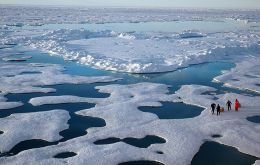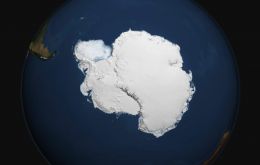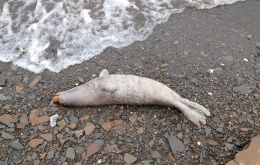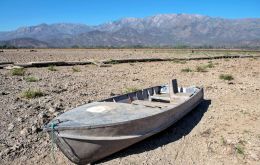MercoPress. South Atlantic News Agency
Tag: global warming
-
Friday, August 9th 2019 - 08:13 UTC
German lawmakers propose higher VAT rate on meat to combat global warming

Green and Social Democrat (SPD) politicians in Germany say the 7% sales tax (VAT) rate on meat should be raised to 19% to help curb global warming and fund animal welfare improvements.
-
Friday, August 2nd 2019 - 09:59 UTC
Last July, the hottest in history according to WMO, after warmest-ever June

The planet endured what may have been the hottest July in history, the World Meteorological Organization (WMO) said on Thursday, just a week after a European heatwave shattered all-time records and also coming on the heels of the world's warmest-ever June.
-
Wednesday, July 24th 2019 - 23:51 UTC
Dozens perish as Europeans smolder in unprecedented heat

Record high temperatures were reported in Belgium and Netherlands Wednesday amid a heatwave that hit all Europe and brought 40 degrees Celsius to places like Siberia and leaving over people dead by the dozen in Greece. It has also been reported to be Sweden's hottest July since 1756.
-
Friday, July 19th 2019 - 09:54 UTC
June was the hottest month in 140 years, says NOAA

June 2019 was the hottest in 140 years, setting a global record, according to the latest monthly global climate report released on Thursday by the US National Oceanic and Atmospheric Administration.
-
Tuesday, July 2nd 2019 - 09:55 UTC
Loss of Antarctica's sea ice cover, particularly since 2014, baffles scientists

After mysteriously expanding for decades, Antarctica's sea ice cover melted by an area four times greater than France in just a few years and now stands at a record low, according to a study published on Monday.
-
Thursday, June 13th 2019 - 08:42 UTC
Seals mortality in Bering Sea beaches baffles scientists; above normal water temperatures

At least 60 dead seals have been discovered along beaches of the Bering Sea and Chukchi Sea in northwestern Alaska, and scientists are trying to determine what caused their deaths, the National Oceanic and Atmospheric Administration (NOAA) said on Wednesday.
-
Monday, May 6th 2019 - 09:04 UTC
Arctic countries meet in Finland, but not all participants are happy with China's presence

Top diplomats from the United States, Russia and other nations which border the Arctic meet in Finland on Monday to discuss policies governing the polar region, as tensions grow over how to deal with global warming and access to mineral wealth.
-
Tuesday, April 23rd 2019 - 08:32 UTC
UK four nations with hottest Easter Monday on record, Met Office says

It has been the hottest Easter Monday on record in all four nations of the UK, the Met Office has said. England reached the highest temperature with 25C (77F) recorded at Heathrow, Northolt and Wisley.
-
Thursday, March 21st 2019 - 08:59 UTC
A 12 sq. km lagoon, one hour's drive from Santiago, goes completely dry

The cows and horses would have come for the last blades of grass. Now their bones are scattered on the cracked earth, victims of drought that wiped Santiago's weekend playground Lake Aculeo from the map.
-
Tuesday, February 26th 2019 - 09:18 UTC
Crack in Antarctica's Brunt Ice Shelf: further evidence of climate change?

A chasm and a crack on the Brunt Ice Shelf in Antarctica are creeping closer and closer to one another, and when the two finally meet, a slab of ice twice the size of New York City will break away and float out to sea. The two glacial flaws are about 4km apart, and it could take days or months for them to finally rendezvous. But when they do, the iceberg that forms in the Weddell Sea will not be the largest to orbit Antarctica. In fact, it might not even make the historical top 20.
